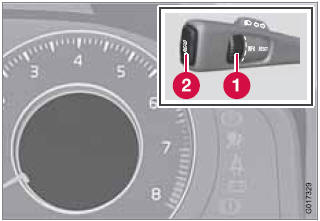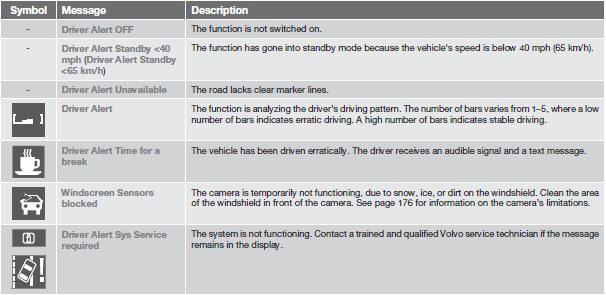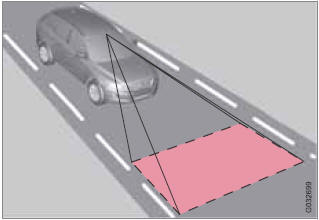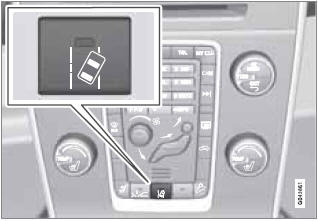Volvo XC60: Driver Alert System
Introduction
The Driver Alert System is designed to help a driver who may be becoming fatigued or who is inadvertently leaving the lane.
The Driver Alert System consists of two different functions that can be switched on together or separately.
• Driver Alert Control (DAC)
• Lane Departure Warning (LDW), see
page 183
When one or both of the functions has been switched on, it is in standby mode and is activated when the vehicle exceeds a speed of 40 mph (65 km/h).
The function deactivates if the vehicle's speed goes under 37 mph (60 km/h).
Both functions use a camera that is dependent on the road/lane being clearly marked by painted lines on each side.
WARNING
The Driver Alert System does not function in
all situations and is designed to be a supplementary
aid. It is not, however, intended
to replace the driver’s attention and judgement.
Driver Alert Control (DAC)– introduction

This function is intended to alert the driver if his/her driving becomes erratic, such as if the driver is distracted or fatigued.
NOTE
The camera has certain limitations, see
page 159.
A camera monitors the painted lines marking the lane in which the vehicle is traveling and compares the direction of the road with the driver’s movements of the steering wheel. The driver is alerted if the vehicle does not follow the lane smoothly.
DAC is designed to help detect a slowly changing driving pattern. It is primarily intended to be used on main roads and is not meant for use in city traffic.
WARNING
• DAC is not intended to extend the duration
of driving. Always plan breaks at
regular intervals to help remain alert.
• In certain cases, fatigue may not affect
the driver’s behavior. In situations of
this type, no warning will be provided.
Therefore, it is important to take breaks
at regular intervals, regardless of
whether or not DAC has given a warning.
Limitations
In certain situations, DAC may provide warnings even if the driver’s driving pattern has not become erratic.
• if the driver is testing the LDW function
• in strong crosswinds
• on grooved road surfaces.
Operating DAC
Certain settings can be made from the menu system controlled from the center instrument panel.
The current system status can be checked on the trip computer’s display by using the buttons on the left steering wheel lever.

1 Thumb wheel. Turn this wheel until Driver
Alert is displayed. The second line shows
the alternatives Off, Driver Alert Standby
<40 mph (Driver Alert Standby <65 km/h), Unavailable or [-----], i.e., the
number
of bars.
2 READ button. Confirms and erases a message
in the display.
Activating DAC
Press MY CAR in the center instrument panel
and go to Car settings
 Driver Alert and
select On. See page 133 for more information
on the menu system.
Driver Alert and
select On. See page 133 for more information
on the menu system.

The function is activated when the vehicle exceeds a speed of 40 mph (65 km/h). The display will show level markings of 1–5 bars, where a low number of bars indicates erratic driving. A high number of bars indicates stable driving.
If the vehicle is being driven erratically, the driver will be alerted by an audible signal and the message Driver Alert, Time for a break is displayed. The warning will be repeated after a short time if the driving pattern remains the same.
WARNING
• An alert should be taken seriously since
it is sometimes difficult for a driver to
realize that he/she is fatigued.
• In the event of a warning or if the driver
feels fatigued, stop as soon as possible
in a safe place and rest.
Symbols and messages in the display

Lane Departure Warning (LDW)– introduction

This function is designed to help reduce the risk of accidents in situations where the vehicle leaves its lane and there is a risk of driving off the road or into the opposite lane. LDW consists of a camera that monitors the lane’s side marker lines. The driver is alerted by an audible signal if the vehicle crosses a side marker line or the road’s center dividing line.
Operation and function

LDW can be switched on or off by pressing the button on the center console. A light in the button illuminates when the function is on.
The trip computer display shows Lane Depart Warn Standby <40 mph (Lane Depart Warn Standby <65 km/h) when the function is in standby mode.
When LDW is in standby mode, the function is activated automatically after the camera has monitored the road’s side marker lines and the vehicle’s speed exceeds 40 mph (65 km/h).
Lane Depart Warn Available will be displayed.
If the vehicle’s speed falls below 37 mph (60 km/h), LDW will return to standby mode and Lane Depart Warn Standby <40 mph (65 km/h) will be displayed.
If the camera can no longer monitor the road’s side marker lines, Lane Depart Warn Unavailable will be displayed.
If the vehicle unexpectedly crosses the lane’s left or right side marker lines, the driver will be alerted by an audible signal.
No warning signal will be given in the following
situations:
• The turn signal is being used
• The driver’s foot is on the brake pedal
• The throttle pedal is pressed quickly
• If the steering wheel is moved quickly
• In sharp turns that cause the vehicle’s body to sway
See page 176 for information on the camera’s limitations.
WARNING
The driver will only be warned once for each
time the wheels cross a marker line. No
alarm will be given if a marker line is
between the wheels.
Settings
Settings for Lane Departure Warning can be
made in the menu system by pressing My
Car. Go to Settings
 Car settings
Car settings
 Driver
support systems
Driver
support systems
 Lane Departure
Warning.
Lane Departure
Warning.
There are two alternatives:
On at start-up: This selection switches LDW on each time the engine is started. Otherwise, the system will be in the mode that it was in when the engine was switched off.
Increased sensitivity: This selection increases the function’s sensitivity. Warnings will be given at an earlier stage and fewer limitations apply. When this setting is being used, the system only needs to monitor lane marker lines on one side of the vehicle to change status to Lane Depart Warn Available.
Symbols and messages in the display


See also:
Homelink wireless control system
Your new mirror comes with an integrated HomeLink Universal Transceiver, which
allows you to program the mirror to activate your garage door(s), estate gate, home
lighting, etc. The mirror actually learns the codes from your various existing tr ...
Useful information
This Operator's Manual describes all models and all standard and optional equipment
of your vehicle available at the time of publication of the Operator's Manual. Country-specific
differences are possible. Please note that your vehicle ...

 Collision warning with Full Auto-brake and Pedestrian Detection
Collision warning with Full Auto-brake and Pedestrian Detection